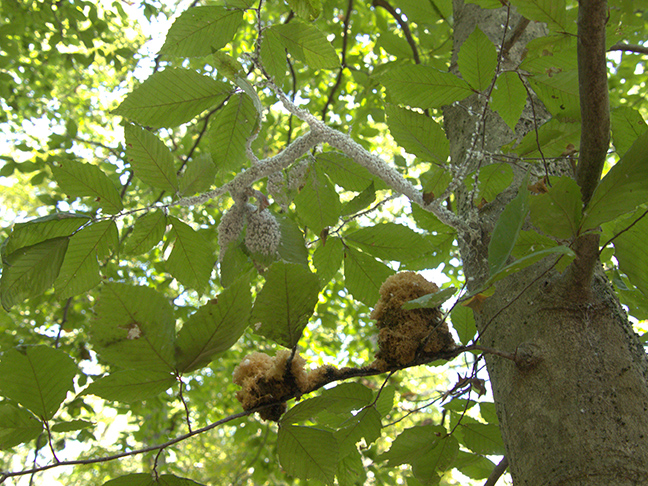Happy Mystery Tuesday! Can you guess what is pictured in photo below?

The answer to last week’s mystery is boogie woogie (or beech blight) aphids, Grylloprociphilus imbricator, pictured below:

The boogie woogie aphid is a bluish-gray, small to medium sized aphid. The rear half of the aphid’s abdomen may be obscured with a dense, white, fluffy secretion interspersed with long, white, waxy filaments.
The wax is essentially a shield for the aphid. Should a predator bite into the woolly floss it will come away with nothing but wax.
Aphids usually specialize in one kind of plant, and the boogie woogie aphid primarily feasts on the sap of American beech trees. Brilliant white wax produced by thousands of boogie woogie aphids can turn beech branches snowy white.
When disturbed, the aphids break into a massive swaying, wriggling dance with abdomens and wax held high. This group reaction is thought to confuse or distract predators.
Many aphid species can reproduce rapidly by parthenogenesis, where females give live birth to daughters without mating. They can build up great numbers quickly, which is why aphids are often pests of crops in late-Summer or early-Autumn.
Soon, a generation of both male and female winged aphids are produced. They will disperse and mate before Winter comes. The winged females will lay eggs that last over Winter to start the cycle again in the Spring.
Because beech sap has far more sugar than nutrients, aphids get rid of some sugar by excreting it in the form of honeydew. Under a mass of aphids (as pictured) the honeydew will accumulate on the branches or the ground below the aphid colony and will attract flies, bees, wasps, and other insects.
Mystery Monday is sponsored by the Spy Newspapers and Adkins Arboretum.



Write a Letter to the Editor on this Article
We encourage readers to offer their point of view on this article by submitting the following form. Editing is sometimes necessary and is done at the discretion of the editorial staff.